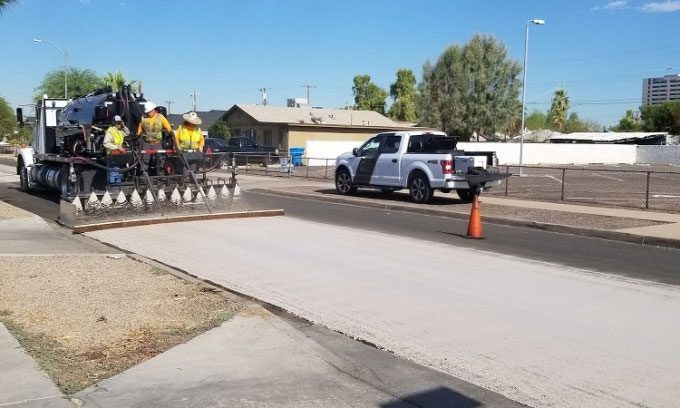Phoenix, one of the hottest cities in the U.S., is applying heat-reflective paint to many sidewalks to cope with the intense sun.
July 15 marked the 16th consecutive day with temperatures reaching 43.3 degrees Celsius (110 degrees Fahrenheit) or higher this summer in the Arizona city. As of now, the average temperature for July here is 45 degrees Celsius (113 degrees Fahrenheit). Authorities in Phoenix are looking for ways to mitigate the heat by transforming the appearance of sidewalks, Yahoo reported on July 16.

Workers applying cooling paint to sidewalks. (Photo: The State Press)
The sidewalk cooling program in the city is akin to applying sunscreen to the pavement. Essentially, the city is coating the sidewalks with a light-colored paint that helps reflect sunlight and absorb less heat. As a result, the surface temperature of the sidewalks is cooler than that of conventional asphalt. At noon, when the sun is at its brightest, the surface temperature of the sidewalks is on average 5.8 to 6.6 degrees Celsius (10.4 to 11.9 degrees Fahrenheit) cooler than asphalt.
City officials hope this measure can help reduce the “urban heat island effect”, where heat absorbed by hard surfaces during the day is released at night. At night, the air temperature at a height of 2 meters above the painted sidewalk is 0.2 degrees Celsius (0.4 degrees Fahrenheit) lower compared to untreated asphalt. This is an important project aimed at sustaining the city amid rising temperature trends.
According to Ryan Stevens, a local resident, opinions on the sidewalk paint are mixed. “It’s a different color that some people find pleasing while others do not. But whenever we discuss cooling the sidewalks, I always get asked: When will it be our neighborhood’s turn? This shows that there are a lot of people interested,” shared Ryan Stevens, a technical manager.
Currently, Phoenix has applied cooling paint to approximately 160 kilometers (99 miles) of sidewalks, with plans to increase this to 190 kilometers (118 miles) by the end of the year.




















































